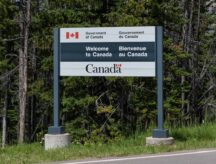Recent policies that may make home ownership more affordable for eligible newcomers to Canada
On April 11, 2024, Deputy Prime Minister/Finance Minister Chrystia Freeland announced several new housing affordability measures designed to help first-time buyers and current homeowners.
In light of the federal restrictions on foreign home buyers last year (more on that later), newcomers to Canada may be curious if they are eligible for any of the recently announced housing affordability measures.
This article outlines how policies implementing increased RRSP withdrawal limits and extended mortgage terms can benefit newcomers to Canada, making it easier to purchase their first home.
Discover if You Are Eligible for Canadian Immigration
We also provide a clear guide on what these changes mean and discuss how newcomers, especially temporary residents such as international students and foreign workers, can pursue them.
Understanding Canada’s restrictions on foreign home buyers
Enforced beginning on January 1, 2023, the Canadian government enacted the Prohibition on the Purchase of Residential Property by Non-Canadians Act.
This government policy, which was recently extended until January 1, 2027, was put in place to restrict “non-Canadians* ... from buying residential property, ... defined as buildings with 3 ... or [fewer dwelling units, including] semi-detached houses, and condominium units.”
*Non-Canadians are defined as “those who are not Canadian citizens or permanent residents”
There are certain situations where non-Canadians, including temporary residents such as foreign workers or international students, may still be eligible to purchase a residential property in Canada. Click here for more information.
Increased Registered Retirement Savings Plan withdrawal limits
Effective April 16, 2024, First-Time Home Buyers will be able to withdraw more money from their Registered Retirement Savings Plan (RRSP) to make a down payment on their first home.
Specifically, after the change takes effect, first-time home buyers across Canada will be able to withdraw $60,000 to put towards a down payment on the property they are purchasing, an increase of $25,000 from the previous allowable withdrawal limit. Before April 16, first-time home buyers could only withdraw $35,000 from their RRSP for a down payment on a home.
According to Minister Freeland, increased RRSP withdrawal limits “plus the Tax-Free First Home Savings Account* [FHSA], can be combined.” Together, Freeland says, these initiatives “will give younger Canadians more tools to save what is actually needed” to purchase their first home.
*More on FHSAs below.
In other words, the government’s decision to increase RRSP withdrawal limits is expected to allow Canadians, including eligible newcomers, to access more money they can use for a down payment, easing the initial financial burden of purchasing a home in Canada.
Canada’s tax-free FHSA
In 2022, the Canadian government introduced a new savings account called an FHSA. This tax-free savings account enables Canadian citizens and permanent residents to save up to $8,000 per year towards their first home. This account is unique because it allows eligible account holders to enjoy several tax-related benefits while they save up to buy their first home in Canada such as:
- Contributions made to an FHSA are tax-deductible and they provide account holders with tax rebates
- Growth that occurs with all money that is contributed to an FHSA is tax-free
- When an account holder decides they are ready to withdraw from their FHSA for a down payment on their home, the money taken out of this account does not incur taxes
Note: Tax-free FHSAs have a lifetime contribution limit of $40,000.
Extended RRSP repayment period
According to the Canadian government, Canadians with an RRSP, including newcomers, will soon have more than twice as long as they once did “to start repaying their RRSP contributions [after making] a withdrawal to pay for the deposit on a home.”
Specifically, according to Minister Freeland, “first-time home buyers who withdraw money from their RRSPs [by] Dec. 31, 2025, will now have five years to begin repayments.” Before the extension of this repayment period, Canadians and newcomers with an RRSP had just two years before they needed to begin repaying their contributions.
This extension is expected to enable eligible account holders to have an increased level of financial flexibility when it comes to repaying their RRSP, something that will be beneficial both in the short term and for long-term budget planning for new homeowners.
Extended amortization period for mortgages
Beginning on August 1 this year, some* first-time homebuyers with insured mortgages “will get 30 years to pay [their] mortgage back”, according to the Canadian government.
Note: First-time homebuyers will be eligible for this extended amortization period only if they purchase a newly built home.
Longer mortgage amortization periods have a positive impact on homeowners in Canada because they reduce the monthly payments that homeowners need to make on their property.
Therefore, this initiative is expected to, in the words of Minister Freeland, make it possible for “more younger Canadians [to] afford to pay that monthly mortgage on a new home". Ultimately, this should, in turn, generally make homeownership more accessible for younger Canadians across the country. This may also benefit newcomers who typically immigrate to Canada as young adults.
Changes to the Canadian Mortgage Charter
The Canadian government updated its Canadian Mortgage Charter this fall, an update that will especially serve to benefit newcomers to Canada and other “vulnerable borrowers.”
A summary of the government’s most recent Charter update is available below.
According to a recent article from CBC News, in line with the new Mortgage Charter update:
- Banks will now be required to “reach out to homeowners four to six months in advance of their mortgage renewal date to inform them of affordability options”
- Lenders will now have to contact borrowers "up to 24 months in advance of a homeowner's mortgage renewal to discuss options”
- Lenders must* now “provide temporary extensions on the amortization period for mortgage holders who were facing financial difficulties.”
*It should be noted that this once temporary extension measure “is now being made permanent … depending on a homeowner's circumstances” according to Canada’s Deputy Prime Minister/Finance Minister. Freeland also said that this new update may even apply to “people with insured mortgages and making that change will not come with any extra fees or penalties.”
Further to the above, according to the same CBC News article, the government has announced that the following Charter updates will assist “vulnerable borrowers under financial strain”:
- Waiving fees and costs that would otherwise have been charged for mortgage relief measures
- Waiving interest on interest when mortgage relief measures result in mortgage payments that fail to cover interest payments on a loan
- Insured mortgage holders will be exempt from “re-qualifying under the stress test when switching lenders at the time of a mortgage renewal”
- Borrowers will be allowed “to make lump sum payments to avoid negative amortization or sell their principal residence without incurring prepayment penalties”
Homeowners should now have more time to plan for their financial future through the extended notice periods imposed on banks and other lenders. In addition, certain people are expected to see some fees and interest payments waived and housing may now become more affordable through extended amortization periods.
- Do you need Canadian immigration assistance? Contact the Contact Cohen Immigration Law firm by completing our form
- Send us your feedback or your non-legal assistance questions by emailing us at media@canadavisa.com






